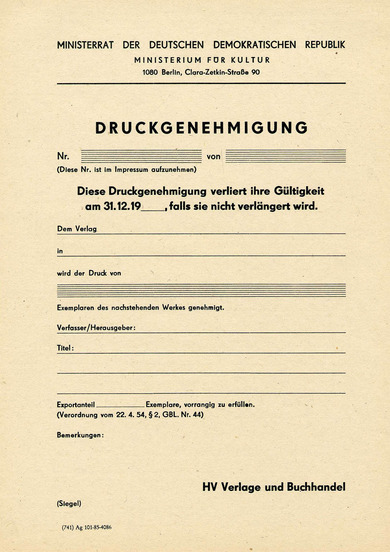Imprimatur
Officially, no book in the German Democratic Republic (GDR) could be published without the state’s prior consent, which practically amounted to a form of pre-censorship. This control of the media was, however, euphemistically called “Appraisal” and “Approval” rather than “Censorship”. The Hauptverwaltung Verlage und Buchhandel or HV (Administrative Centre for Publishers and the Book Trade) in the Ministry of Culture, which had emerged out of the Kultureller Beirat für das Verlagswesen (Cultural Advisory Committee for Publishing), formed in 1946, was responsible for granting imprimaturs. Every manuscript had to be submitted to it together with a publishing report and often a report from an external reviewer. This often resulted in an extended exchange of correspondence between the HV, the publishers and the author to bring about changes in the text. The final decision on whether the book could be published rested with the HV. The allocation of paper, which was a scarce commodity like so many other things in the GDR, could have a further impact on the size of a title’s print.
The almost completely intact censorship files take up 130 metres of shelf space in the Federal Archives in Lichterfelde, Berlin. To aid research, part of the files have been digitalised and can be viewed on the Federal Archives’ website. The illegal written information of peace, environmental and human rights groups was published beyond the reach of state censorship. Likewise, original graphic magazines that were circulated in small editions among the contributing artists’ social circles arose from the 1980s onwards.

